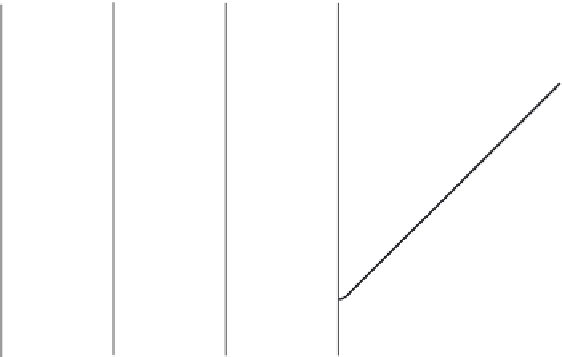Geoscience Reference
In-Depth Information
Free Residual
Formed
Chloramines
Formed
Chloramines
Destroyed
Demand
Free
Available
Chlorine
Residual
Combined Chlorine Residual
Chlorine Added to Water
FIGURE 23.4
Breakpoint chlorination curve.
■
EXAMPLE 23.110
Problem:
A chlorinator setting is increased by 2 lb/day. The chlorine residual before the increased
dosage was 0.2 mg/L. After the increased chlorine dose, the chlorine residual was 0.5 mg/L.
The average flow rate being chlorinated is 1.25 MGD. Is the water being chlorinated beyond the
breakpoint?
Solution:
Calculate the expected increase in chlorine residual using the mg/L to lb/day equation:
Increase in chlorine (lb/day) = Expected increase (mg/L) × Flow (MGD) × 8.34 lb/gal
2 lb/day =
x
mg/L × 1.25 MGD × 8.34 lb/gal
x
= (2 lb/day)/(1.25 MGD × 8.34 lb/gal) = 0.19 mg/L
The actual increase in residual chlorine is
0.5 mg/L - 0.19 mg/L = 0.31 mg/L
■
EXAMPLE 23.111
Problem:
A chlorinator setting of 18 lb chlorine per 24 hr results in a chlorine residual of 0.3 mg/L.
The chlorinator setting is increased to 22 lb per 24 hr. The chlorine residual increased to 0.4 mg/L
at this new dosage rate. The average flow being treated is 1.4 MGD. On the basis of these data, is the
water being chlorinated past the breakpoint?
Solution:
Calculate the expected increase in chlorine residual:
Increase in chlorine (lb/day) = Expected increase (mg/L) × Flow (MGD) × 8.34 lb/gal
4 lb/day =
x
mg/L × 1.4 MGD × 8.34 lb/gal
x
= (4 lb/day)/(1.4 MGD × 8.34 lb/gal) = 0.34 mg/L
The actual increase in residual chlorine is
0.4 mg/L - 0.3 mg/L = 0.1 mg/L



Search WWH ::

Custom Search